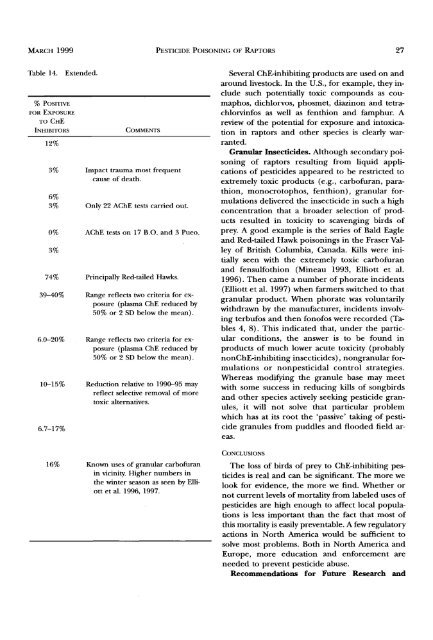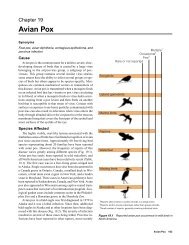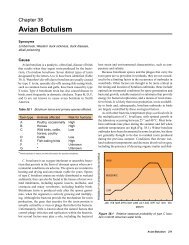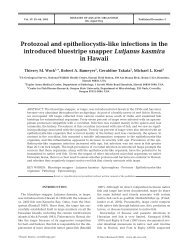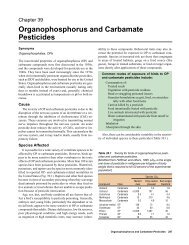poisoning of raptors with organophosphorus and carbamate ...
poisoning of raptors with organophosphorus and carbamate ...
poisoning of raptors with organophosphorus and carbamate ...
Create successful ePaper yourself
Turn your PDF publications into a flip-book with our unique Google optimized e-Paper software.
M•mcvI 1999 PESTICIDE POISONING OF RAPTORS 27<br />
Table 14. Extended.<br />
% POSITIVE<br />
FOR EXPOSURE<br />
TO CHE<br />
INHIBITORS<br />
12%<br />
3%<br />
6%<br />
3%<br />
o%<br />
3%<br />
74%<br />
39-40%<br />
COMMENTS<br />
Impact trauma most frequent<br />
cause <strong>of</strong> death.<br />
Only 22 AChE tests carried out.<br />
AChE tests on 17 B.O. <strong>and</strong> 3 Pueo.<br />
Principally Red-tailed Hawks.<br />
Range reflects two criteria for exposure<br />
(plasma ChE reduced by<br />
50% or 2 SD below the mean).<br />
6.0-20% Range reflects two criteria for exposure<br />
(plasma ChE reduced by<br />
50% or 2 SD below the mean).<br />
10-15% Reduction relative to 1990-95 may<br />
reflect selective removal <strong>of</strong> more<br />
6.7-17%<br />
toxic<br />
alternatives.<br />
Several ChE-inhibiting products are used on <strong>and</strong><br />
around livestock. In the U.S., for example, they include<br />
such potentially toxic compounds as coumaphos,<br />
dichlorvos, phosmet, diazinon <strong>and</strong> tetrachlorvinfos<br />
as well as fenthion <strong>and</strong> famphur. A<br />
review <strong>of</strong> the potential for exposure <strong>and</strong> intoxication<br />
in <strong>raptors</strong> <strong>and</strong> other species is clearly warranted.<br />
Granular Insecticides. Although secondary <strong>poisoning</strong><br />
<strong>of</strong> <strong>raptors</strong> resulting from liquid applications<br />
<strong>of</strong> pesticides appeared to be restricted to<br />
extremely toxic products (e.g., carb<strong>of</strong>uran, parathion,<br />
monocrotophos, fenthion), granular formulations<br />
delivered the insecticide in such a high<br />
concentration that a broader selection <strong>of</strong> products<br />
resulted in toxicity to scavenging birds <strong>of</strong><br />
prey. A good example is the series <strong>of</strong> Bald Eagle<br />
<strong>and</strong> Red-tailed Hawk <strong>poisoning</strong>s in the Fraser Valley<br />
<strong>of</strong> British Columbia, Canada. Kills were initially<br />
seen <strong>with</strong> the extremely toxic carb<strong>of</strong>uran<br />
<strong>and</strong> fensulfothion (Mineau 1993, Elliott et al.<br />
1996). Then came a number <strong>of</strong> phorate incidents<br />
(Elliott et al. 1997) when farmers switched to that<br />
granular product. When phorate was voluntarily<br />
<strong>with</strong>drawn by the manufacturer, incidents involving<br />
terbufos <strong>and</strong> then fon<strong>of</strong>os were recorded (Tables<br />
4, 8). This indicated that, under the particular<br />
conditions, the answer is to be found in<br />
products <strong>of</strong> much lower acute toxicity (probably<br />
nonChE-inhibiting insecticides), nongranular formulations<br />
or nonpesticidal control strategies.<br />
Whereas modifying the granule base may meet<br />
<strong>with</strong> some success in reducing kills <strong>of</strong> songbirds<br />
<strong>and</strong> other species actively seeking pesticide granules,<br />
it will not solve that particular problem<br />
which has at its root the 'passive' taking <strong>of</strong> pesticide<br />
granules from puddles <strong>and</strong> flooded field ar-<br />
eas.<br />
CONCLUSIONS<br />
16% Known uses <strong>of</strong> granular carb<strong>of</strong>uran<br />
in vicinity. Higher numbers in<br />
the winter season as seen by Elliott<br />
et al. 1996, 1997.<br />
The loss <strong>of</strong> birds <strong>of</strong> prey to ChE-inhibiting pesticides<br />
is real <strong>and</strong> can be significant. The more we<br />
look for evidence, the more we find. Whether or<br />
not current levels <strong>of</strong> mortality from labeled uses <strong>of</strong><br />
pesticides are high enough to affect local populations<br />
is less important than the fact that most <strong>of</strong><br />
this mortality is easily preventable. A few regulatory<br />
actions in North America would be sufficient to<br />
solve most problems. Both in North America <strong>and</strong><br />
Europe, more education <strong>and</strong> enforcement are<br />
needed to prevent pesticide abuse.<br />
Recommendations for Future Research <strong>and</strong>


